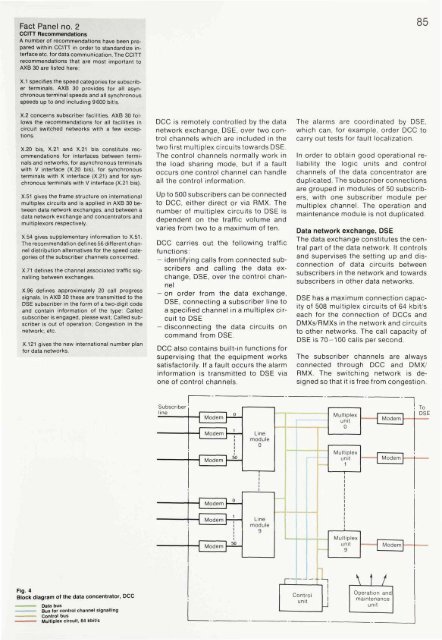diavox courier 700, digital system telephone for md 110 data
diavox courier 700, digital system telephone for md 110 data
diavox courier 700, digital system telephone for md 110 data
You also want an ePaper? Increase the reach of your titles
YUMPU automatically turns print PDFs into web optimized ePapers that Google loves.
Fact Panel no. 2<br />
CCITT Recommendations<br />
A number of recommendations have been prepared<br />
within CCITT in order to standardize interface<br />
etc. <strong>for</strong> <strong>data</strong> communication. The CCITT<br />
recommendations that are most important to<br />
AXB 30 are listed here:<br />
85<br />
X.1 specifies the speed categories <strong>for</strong> subscriber<br />
terminals. AXB 30 provides <strong>for</strong> all asynchronous<br />
terminal speeds and all synchronous<br />
speeds up to and including 9600 bit/s.<br />
X.2 concerns subscriber facilities. AXB 30 follows<br />
the recommendations <strong>for</strong> all facilities in<br />
circuit switched networks with a few exceptions.<br />
X.20 bis, X.21 and X.21 bis constitute recommendations<br />
<strong>for</strong> interfaces between terminals<br />
and networks, <strong>for</strong> asynchronous terminals<br />
with V interface (X.20 bis), <strong>for</strong> synchronous<br />
terminals with X interface (X.21) and <strong>for</strong> synchronous<br />
terminals with V interface (X.21 bis).<br />
X.51 gives the frame structure on international<br />
multiplex circuits and is applied in AXB 30 between<br />
<strong>data</strong> network exchanges, and between a<br />
<strong>data</strong> network exchange and concentrators and<br />
multiplexors respectively.<br />
X.54 gives supplementary in<strong>for</strong>mation to X.51.<br />
The recommendation defines 56 different channel<br />
distribution alternatives <strong>for</strong> the speed categories<br />
of the subscriber channels concerned.<br />
X.71 defines the channel associated traffic signalling<br />
between exchanges.<br />
X.96 defines approximately 20 call progress<br />
signals. In AXB 30 these are transmitted to the<br />
DSE subscriber in the <strong>for</strong>m of a two-digit code<br />
and contain in<strong>for</strong>mation of the type: Called<br />
subscriber is engaged, please wait; Called subscriber<br />
is out of operation; Congestion in the<br />
network; etc.<br />
X.121 gives the new international number plan<br />
<strong>for</strong> <strong>data</strong> networks.<br />
DCC is remotely controlled by the <strong>data</strong><br />
network exchange, DSE, over two control<br />
channels which are included in the<br />
two first multiplex circuits towards DSE.<br />
The control channels normally work in<br />
the load sharing mode, but if a fault<br />
occurs one control channel can handle<br />
all the control in<strong>for</strong>mation.<br />
Up to 500 subscribers can be connected<br />
to DCC, either direct or via RMX. The<br />
number of multiplex circuits to DSE is<br />
dependent on the traffic volume and<br />
varies from two to a maximum of ten.<br />
DCC carries out the following traffic<br />
functions:<br />
- identifying calls from connected subscribers<br />
and calling the <strong>data</strong> exchange,<br />
DSE, over the control channel<br />
- on order from the <strong>data</strong> exchange,<br />
DSE, connecting a subscriber line to<br />
a specified channel in a multiplex circuit<br />
to DSE<br />
- disconnecting the <strong>data</strong> circuits on<br />
command from DSE.<br />
DCC also contains built-in functions <strong>for</strong><br />
supervising that the equipment works<br />
satisfactorily. If a fault occurs the alarm<br />
in<strong>for</strong>mation is transmitted to DSE via<br />
one of control channels.<br />
The alarms are coordinated by DSE,<br />
which can, <strong>for</strong> example, order DCC to<br />
carry out tests <strong>for</strong> fault localization.<br />
In order to obtain good operational reliability<br />
the logic units and control<br />
channels of the <strong>data</strong> concentrator are<br />
duplicated. The subscriber connections<br />
are grouped in modules of 50 subscribers,<br />
with one subscriber module per<br />
multiplex channel. The operation and<br />
maintenance module is not duplicated.<br />
Data network exchange, DSE<br />
The <strong>data</strong> exchange constitutes the central<br />
part of the <strong>data</strong> network. It controls<br />
and supervises the setting up and disconnection<br />
of <strong>data</strong> circuits between<br />
subscribers in the network and towards<br />
subscribers in other <strong>data</strong> networks.<br />
DSE has a maximum connection capacity<br />
of 508 multiplex circuits of 64 kbit/s<br />
each <strong>for</strong> the connection of DCCs and<br />
DfvlXs/RMXs in the network and circuits<br />
to other networks. The call capacity of<br />
DSE is 70-100 calls per second.<br />
The subscriber channels are always<br />
connected through DCC and DMX/<br />
RMX. The switching network is designed<br />
so that it is free from congestion.<br />
Fig. 4<br />
Block diagram of the <strong>data</strong> concentrator, DCC<br />
• Data bus<br />
Bus <strong>for</strong> control channel signalling<br />
Control bus<br />
——— Multiplex circuit, 64 kbit/s
















